Spatial–Temporal Pattern Evolution and Differentiation Mechanism of Urban Dual Innovation: A Case Study of China’s Three Major Urban Agglomerations
Abstract
:1. Introduction
2. Materials and Methods
2.1. Study Areas
2.2. Data Sources and Processing
- Defining the study periods: Based on the trend in patent application data over the years, this paper divides the study into four periods: 2000–2005, 2006–2010, 2011–2015, and 2016–2021.
- Cleaning patent data: Removing irrelevant data and extracting patent applicant addresses.
- Geocoding: Using Python, invoking the Amap Auto (www.amap.com, accessed on December 2023) API to geocode patent applicant addresses and obtain latitude and longitude coordinates.
2.3. Methods
2.3.1. Kernel Density
2.3.2. Multi-Ring Buffer
2.3.3. Model
- (1)
- Dependent variable
- (2)
- Independent variable
- Economic Size (GDP): GDP reflects a city’s overall economic strength and market size. Typically, areas with larger economic outputs are more likely to foster innovation.
- Economic Development Level (per capita GDP): Per capita GDP denotes the level and stage of economic development. Regions with higher per capita GDP are generally more conducive to innovation.
- Industrialization Level (industrialization rate): The level of industrialization represents a region’s industrial base and manufacturing production capacity. On the one hand, a high level of industrialization can provide a material basis and technological platform for technological innovation. On the other hand, an excessively high industrial ratio may imply a reduction in the proportion of the tertiary sector, and innovation is more likely to occur in areas with a developed modern service industry rather than in a purely industrial city.
- Resident Income (the average wage of employed staff): Income levels influence purchasing power. Higher average wages boost demand for innovative products and services and increase societal investment in innovation, thus impacting urban innovation development.
- Innovation Elements (number of industrial enterprises): A greater number of industrial enterprises may imply a richer pool of innovation resources and a more diverse range of technological demands, thereby influencing the occurrence and agglomeration of innovation.
- Government support (public financial expenditure on scientific and technological activities): Government support is crucial for the occurrence and agglomeration of innovative activities. It provides strong financial guarantees for research and development through funding support and tax incentives, effectively promoting urban innovation.
- Internationalization Level (actual utilization of foreign capital): Foreign direct investment not only brings in foreign capital but also advanced technology and management experience from foreign enterprises. On the one hand, this may promote urban innovation through knowledge spillover effects. On the other hand, it may also affect the development of urban innovation by capturing local enterprises’ market share and innovation resources due to the protection of core knowledge by foreign enterprises.
- Collaborative Innovation (number of cooperative patents): Innovation cooperation can promote the exchange of knowledge and technology, thereby influencing the development of urban innovation.
- Infrastructure (per capita urban road area): Per capita urban road area is an important indicator of urban infrastructure level. It directly affects the efficiency of logistics and the smoothness of economic activities, thereby providing the necessary material basis and transportation support for innovative activities.
- Ecological Environment (green coverage rate of built-up areas): The green coverage rate of built-up areas is an important indicator reflecting the quality of the ecological environment. A good ecological environment can attract the agglomeration of innovative talents, which in turn affects the layout of innovative enterprises and elements, providing a favorable environmental foundation for the emergence of innovative activities.
- Cultural Services (number of library books per 100 people): The number of books in public libraries is an indicator of the level of cultural resources and services in a region. Innovative activities are more likely to occur in regions with a diverse and open cultural atmosphere.
- Public Services (number of hospital beds): The number of hospital beds is an important reflection of urban public service facilities and social security. A good level of public services and a social security system can effectively promote the agglomeration of innovative talents, thereby influencing urban innovation.
- (3)
- Panel data model
3. Results and Analysis
3.1. Evolution of Urban Dual Innovation in Three Urban Agglomerations
3.1.1. Beijing–Tianjin–Hebei Urban Agglomeration
3.1.2. Yangtze River Delta Urban Agglomeration
3.1.3. Pearl River Delta Urban Agglomeration
3.2. The Impact Factors of Urban Dual Innovation Evolution
3.2.1. Analysis of Individual Fixed Effects Regression Results
3.2.2. Analysis of Time Fixed Effects Regression Results
3.3. The Spatial Relationship and Organizational Patterns of Urban Dual Innovation
3.3.1. The Location Relationship between Breakthrough Innovation and Incremental Innovation
3.3.2. The Spatial Organization Patterns of Urban Dual Innovation
4. Discussion
5. Conclusions
Author Contributions
Funding
Data Availability Statement
Conflicts of Interest
References
- Romer, P. Endogenous technological-change. J. Polit. Econ. 1990, 98, 71–102. [Google Scholar] [CrossRef]
- Balland, P.; Rigby, D. The geography of complex knowledge. Econ. Geogr. 2017, 93, 1–23. [Google Scholar] [CrossRef]
- Schumpeter, J. The Theory of Economic Development; Springer: London, UK, 1921; pp. 181–186. [Google Scholar]
- Prahalad, C.; Hamel, G. The core competence of the corporation. Harv. Bus. Rev. 1990, 68, 71–91. [Google Scholar] [CrossRef]
- Teece, D.; Pisano, G. The dynamic capabilities of firms: An introduction. Ind. Corp. Chang. 1994, 3, 537–556. [Google Scholar] [CrossRef]
- Meng, B.; Ming, Y. Smile curves in global value chains: Foreign vs. domestic-owned firms; the U.S. vs. China. Struct. Chang. Econ. Dyn. 2022, 60, 15–29. [Google Scholar] [CrossRef]
- Dennis, W.; Li, J.; Ning, Y. Corporate networks, value chains, and spatial organization: A study of the computer industry in China. Urban Geogr. 2010, 31, 1118–1140. [Google Scholar] [CrossRef]
- Sun, Y.; Zhou, Y.; Lin, G.; Wei, Y. Subcontracting and supplier innovativeness in a developing economy: Evidence from China’s information and communication technology industry. Reg. Stud. 2013, 47, 1766–1784. [Google Scholar] [CrossRef]
- Feldman, P. The Geography of Innovation; Springer: London, UK, 1994; pp. 66–68. [Google Scholar]
- Florida, R. The economic geography of talent. Ann. Am. Assoc. Geogr. 2002, 92, 743–755. [Google Scholar] [CrossRef]
- Liu, Y.; Huang, C.; Zhang, F.; Ma, H. Locational preferences of high-level overseas talent returning to China: Evidence from microdata analysis. Popul. Space Place 2023, 29, e2650. [Google Scholar] [CrossRef]
- Esposito, R.; Rigby, L. Buzz and pipelines: The costs and benefits of local and nonlocal interaction. J. Econ. Geogr. 2019, 19, 753–773. [Google Scholar] [CrossRef]
- Suntje, S. Balancing the spatial localisation ‘Tilt’: Knowledge spillovers in processes of knowledge-intensive services. Geoforum 2015, 65, 374–386. [Google Scholar] [CrossRef]
- Kramer, J.; Diez, R. Catching the local buzz by embedding? Empirical insights on the regional embeddedness of multinational enterprises in Germany and the UK. Reg. Stud. 2021, 46, 1303–1317. [Google Scholar] [CrossRef]
- Balland, P.-A.; Belso-Martínez, J.A.; Morrison, A. The dynamics of technical and business knowledge networks in industrial clusters: Embeddedness, status, or proximity? Econ. Geogr. 2016, 92, 35–60. [Google Scholar] [CrossRef]
- Harmaakorpi, V.; Melkas, H. Knowledge management in regional innovation networks: The case of Lahti, Finland. Eur. Plan. Stud. 2005, 13, 641–659. [Google Scholar] [CrossRef]
- Cooke, P.; Uranga, G.; Etxebarria, G. Regional systems of innovation: An evolutionary perspective. Environ. Plan. A 1998, 30, 1563–1584. [Google Scholar] [CrossRef]
- Makkonen, T.; Weidenfeld, A.; Williams, M. Cross-border regional innovation system integration: An analytical framework. Tijdschr. Econ. Soc. Geogr. 2017, 6, 805–820. [Google Scholar] [CrossRef]
- Docquier, F.; Rapoport, H. Globalization, brain drain, and development. J. Econ. Lit. 2012, 50, 681–730. [Google Scholar] [CrossRef]
- Dequiedt, V.; Zenou, Y. International migration, imperfect information, and brain drain. J. Dev. Econ. 2013, 102, 62–78. [Google Scholar] [CrossRef]
- Gu, H.; Francisco, R.; Liu, Y.; Shen, T. Geography of talent in China during 2000–2015: An eigenvector spatial filtering negative binomial approach. Chin. Geogr. Sci. 2021, 31, 297–312. [Google Scholar] [CrossRef]
- Shearmur, R. Are cities the font of innovation? A critical review of the literature on cities and innovation. Cities 2012, 29, 9–18. [Google Scholar] [CrossRef]
- Balland, P.; Broekel, T.; Diodato, D.; Giuliani, E.; Hausmann, R.; O’Clery, N.; Rigby, D. The new paradigm of economic complexity. Res. Policy 2022, 51, 104450. [Google Scholar] [CrossRef] [PubMed]
- Nico, P.; Thomas, S. The complex nature of regional knowledge production: Evidence on European regions. Res. Policy 2022, 51, 104170. [Google Scholar] [CrossRef]
- Ascani, A.; Bettarelli, L.; Resmini, L.; Balland, P. Global networks, local specialisation and regional patterns of innovation. Res. Policy 2020, 49, 104031. [Google Scholar] [CrossRef]
- Liang, X.; Hidalgo, A.; Balland, P.; Zheng, S.; Wang, J. Intercity connectivity and urban innovation. Comput. Environ. Urban 2024, 109, 102092. [Google Scholar] [CrossRef]
- Michael, E.; Araki, D.; Bennett, G. Regional innovation networks & high-growth entrepreneurship. Res. Policy 2024, 53, 104900. [Google Scholar] [CrossRef]
- Doh, S.; Kim, B. Government support for SME innovations in the regional industries: The case of government financial support program in South Korea. Res. Policy 2014, 43, 1557–1569. [Google Scholar] [CrossRef]
- Fiore, A.; Grisorio, M.; Prota, F. Regional innovation systems: Which role for public policies and innovation agencies? Some insights from the experience of an Italian region. Eur. Plan. Stud. 2011, 19, 1399–1422. [Google Scholar] [CrossRef]
- Benedikt, W. Place-based allocation of R&D funding: Directing the German innovation system for hydrogen technologies in space. Environ. Innov. Soc. Transit. 2024, 52, 100878. [Google Scholar] [CrossRef]
- Schumpeter, J. Business Cycles: A Theoretical Historical and Statistical Analysis of the Capitalist Process; McGraw-Hlill Book Company: New York, NY, USA, 1939; pp. 83–90. [Google Scholar]
- March, G. Exploration and exploitation in organizational learning. Organ. Sci. 1991, 2, 71–87. [Google Scholar] [CrossRef]
- Christensen, C. The Innovator’s Dilemma; Harvard Business School Press: Boston, MA, USA, 2000; pp. 66–72. [Google Scholar]
- Ritala, P.; Hurmelinna-Laukkanen, P. Incremental and radical innovation in coopetition—The role of absorptive capacity and appropriability. J. Prod. Innov. Manag. 2013, 30, 154–169. [Google Scholar] [CrossRef]
- Uzzi, B.; Mukherjee, S.; Stringer, M.; Jones, B. A typical combinations and scientific impact. Science 2013, 342, 468–472. [Google Scholar] [CrossRef] [PubMed]
- Kim, D.; Cerigo, D.; Jeong, H.; Youn, H. Technological novelty profile and invention’s future impact. EPJ Data Sci. 2016, 5, 8. [Google Scholar] [CrossRef]
- Guan, J.; Liu, N. Exploitative and exploratory innovations in knowledge network and collaboration network: A patent analysis in the technological field of nano-energy. Res. Policy 2016, 45, 97–112. [Google Scholar] [CrossRef]
- Mewes, L.; Ebert, T.; Obschoka, M.; Rentfrow, P.; Atof, J.; Gosling, S. Psychological openness and the emergence of breakthrough vs. Incremental innovations: A regional perspective. Econ. Geogr. 2022, 98, 379–410. [Google Scholar] [CrossRef]
- Azoulay, P.; Graff Zivin, J.; Li, D.; Sampat, P. Public R&D investments and private-sector patenting: Evidence from NIH funding rules. Rev. Econ. Stud. 2019, 8, 117–152. [Google Scholar] [CrossRef]
- D’Este, P.; Marzucchi, A.; Rentocchini, F. Exploring and yet failing less: Learning from past and current exploration in R&D. Ind. Corp. Chang. 2018, 27, 525–553. [Google Scholar] [CrossRef]
- Stephan, P.; Veugelers, R.; Wang, J. Reviewers are blinkered by bibliometrics. Nature 2017, 544, 411–412. [Google Scholar] [CrossRef]
- Wang, J.; Lee, Y.; Walsh, J. Funding model and creativity in science: Competitive versus block funding and status contingency effects. Res. Policy 2018, 47, 1070–1083. [Google Scholar] [CrossRef]
- Kahn, K. Understanding innovation. Bus. Horiz. 2018, 3, 453–460. [Google Scholar] [CrossRef]
- Esposito, C. The geography of breakthrough invention in the United States over the 20th century. Res. Policy 2023, 52, 104810. [Google Scholar] [CrossRef]
- Enrico, B.; Ruben, G. The geography of unconventional innovation. Econ. J. 2021, 131, 1466–1514. [Google Scholar] [CrossRef]
- Ren, C.; Wang, T.; Wang, L.; Zhang, Y. ‘Buzz-and-Pipeline’ dynamics of urban dual innovation: Evidence from China’s biomedical industry. Appl. Geogr. 2023, 158, 103048. [Google Scholar] [CrossRef]
- Castaldi, C.; Frenken, K.; Los, B. Related variety, unrelated variety and technological breakthroughs: An analysis of us state-level patenting. Reg. Stud. 2015, 49, 767–781. [Google Scholar] [CrossRef]
- Martin, R.; Sunley, P. Path dependence and regional economic evolution. J. Econ. Geogr. 2006, 6, 395–437. [Google Scholar] [CrossRef]
- Wang, Z.; Zeng, Y.; Wang, X.; Gu, T.; Chen, W. Impact of urban expansion on carbon emissions in the urban agglomerations of Yellow River Basin, China. Land 2024, 13, 651. [Google Scholar] [CrossRef]
- Ke, N.; Zhang, X.; Lu, X.; Kuang, B.; Jiang, B. Regional disparities and influencing factors of eco-efficiency of arable land utilization in China. Land 2022, 11, 257. [Google Scholar] [CrossRef]
- Ma, Z.; Huang, Y. The spatial pattern and influencing factors of urban knowledge-intensive business services: A case study of Wuhan metropolitan area, China. Sustainability 2024, 16, 1110. [Google Scholar] [CrossRef]
- Shukla, A.; Jain, K. Critical analysis of spatial-temporal morphological characteristic of urban landscape. Arab. J. Geosci. 2019, 12, 112. [Google Scholar] [CrossRef]
- Mewes, L. Scaling of atypical knowledge combinations in American metropolitan areas from 1836 to 2010. Econ. Geogr. 2019, 95, 41–361. [Google Scholar] [CrossRef]
- Carolina, C.; Bart, L. Geographical patterns in us inventive activity 1977–1998: The “regional inversion” was underestimated. Res. Policy 2017, 46, 1187–1197. [Google Scholar] [CrossRef]
- Phene, A.; Fladmoe-Lindquist, K. Breakthrough innovations in the US biotechnology industry: The effects of technological space and geographic origin. Strateg. Manag. J. 2006, 27, 369–388. [Google Scholar] [CrossRef]
- Dirk, A.; Carolina, C.; Bart, L. Do ‘liberal market economies’ really innovate more radically than ‘coordinated market economies’?: Hall and Soskice reconsidered. Res. Policy 2009, 38, 181–191. [Google Scholar] [CrossRef]
- Singh, J.; Fleming, L. Lone Inventors as Sources of Breakthroughs: Myth or Reality? Manag. Sci. 2010, 56, 41–56. [Google Scholar] [CrossRef]
- Vasin, S.M.; Timokhina, D.M. Specific effect of innovation factors on socioeconomic development of countries in view of the global crisis. Economies 2024, 12, 190. [Google Scholar] [CrossRef]
- Dempere, J.; Muhammad, Q.; Hesham, A.; Sabir, M. The impact of innovation on economic growth, foreign direct investment, and self-employment: A global perspective. Economies 2023, 11, 182. [Google Scholar] [CrossRef]
- Wu, K.; Chen, Y.; Zhang, H.; Liu, Y.; Wang, M.; Ye, Y.; Gong, W. ICTs capability and strategic emerging technologies: Evidence from Pearl River Delta. Appl. Geogr. 2023, 157, 103019. [Google Scholar] [CrossRef]
- Usman, K.; Liu, Z.; Anjum, M. The evaluation of innovation capacity of China and its influencing factors. Asian Soc. Sci. 2015, 11, 180. [Google Scholar] [CrossRef]
- Fan, P.; Wan, G.; Lu, M. China’s regional inequality in innovation capability, 1995–2006. China World Econ. 2021, 20, 16–36. [Google Scholar] [CrossRef]
- Capello, R.; Caragliu, A.; Lenzi, C. Is innovation in cities a matter of knowledge-intensive services? An empirical investigation. Innovation 2012, 25, 151–174. [Google Scholar] [CrossRef]
- Rodríguez-Pose, A.; Wilkie, C.; Zhang, M. Innovating in “lagging” cities: A comparative exploration of the dynamics of innovation in Chinese cities. Appl. Geogr. 2021, 132, 102475. [Google Scholar] [CrossRef]
- Bathelt, H.; Li, P. Global cluster networks: Foreign direct investment flows from Canada to China. J. Econ. Geogr. 2014, 14, 45–71. [Google Scholar] [CrossRef]
- Agrawal, A.; Galasso, A.; Oettl, A. Roads and innovation. Rev. Econ. Stat. 2017, 99, 417–434. [Google Scholar] [CrossRef]
- Yu, H.; Liu, D.; Zhang, C.; Yu, L.; Yang, B.; Qiao, S.; Wang, X. Research on spatial-temporal characteristics and driving factors of urban development intensity for Pearl River Delta region based on Geodetector. Land 2023, 12, 1673. [Google Scholar] [CrossRef]
- Liu, K.; Liu, W.; Wu, J.; Chen, Z.; Zhang, W.; Liu, F. Spatial differences and influencing factors of urban water utilization efficiency in China. Front. Environ. Sci. 2022, 10, 890187. [Google Scholar] [CrossRef]
- Chang, Q.; Sha, Y.; Chen, Y. The coupling coordination and influencing factors of urbanization and ecological resilience in the Yangtze River Delta urban agglomeration, China. Land 2024, 13, 111. [Google Scholar] [CrossRef]
- Qian, H.; Zhao, C. Space-time analysis of high technology entrepreneurship: A comparison of California and New England. Appl. Geogr. 2018, 95, 111–119. [Google Scholar] [CrossRef]
- Cabrales, A.; Medina, C.; Lavado, A.; Cabrera, R. Managing functional diversity, risk taking and incentives for teams to achieve radical innovations. RD Manag. 2008, 38, 35–50. [Google Scholar] [CrossRef]
- Varadarajan, R. Fortune at the bottom of the innovation pyramid: The strategic logic of incremental innovations. Bus. Horiz. 2009, 52, 21–29. [Google Scholar] [CrossRef]
- Wu, J.; Harrigan, K.; Ang, S.; Wu, Z. The impact of imitation strategy and R&D resources on incremental and radical innovation: Evidence from Chinese manufacturing firms. J. Technol. Transfer. 2019, 44, 210–230. [Google Scholar] [CrossRef]
- Sun, Y.; Liu, J.; Ding, Y. Analysis of the relationship between open innovation, knowledge management capability and dual innovation. Technol. Anal. Strateg. 2020, 32, 15–28. [Google Scholar] [CrossRef]
- Bouncken, R.; Fredrich, V.; Ritala, P.; Kraus, S. Coopetition in new product development alliances: Advantages and tensions for incremental and radical innovation. Br. J. Manag. 2018, 29, 391–410. [Google Scholar] [CrossRef]
- Chen, X.; Xie, H.; Zhou, H. Incremental versus radical innovation and sustainable competitive advantage: A moderated mediation model. Sustainability. 2024, 16, 4545. [Google Scholar] [CrossRef]
- Castaldi, C. The geography of urban innovation beyond patents only: New evidence on large and secondary cities in the United States. Urban Stud. 2023, 61, 1248–1272. [Google Scholar] [CrossRef]
- Agrawal, A.; Cockburn, I.; Rosell, C. Not invented here? Innovation in company towns. J. Urban Econ. 2010, 67, 78–89. [Google Scholar] [CrossRef]
- Guo, D.; Guo, Y.; Jiang, K. Government- subsidized R&D and firm innovation: Evidence from China. Res. Policy 2016, 45, 1129–1144. [Google Scholar] [CrossRef]
- Abbasiharofteh, M.; Kogler, F.; Lengyel, B. Atypical combinations of technologies in regional co-inventor networks. Res. Policy 2023, 52, 104886. [Google Scholar] [CrossRef]
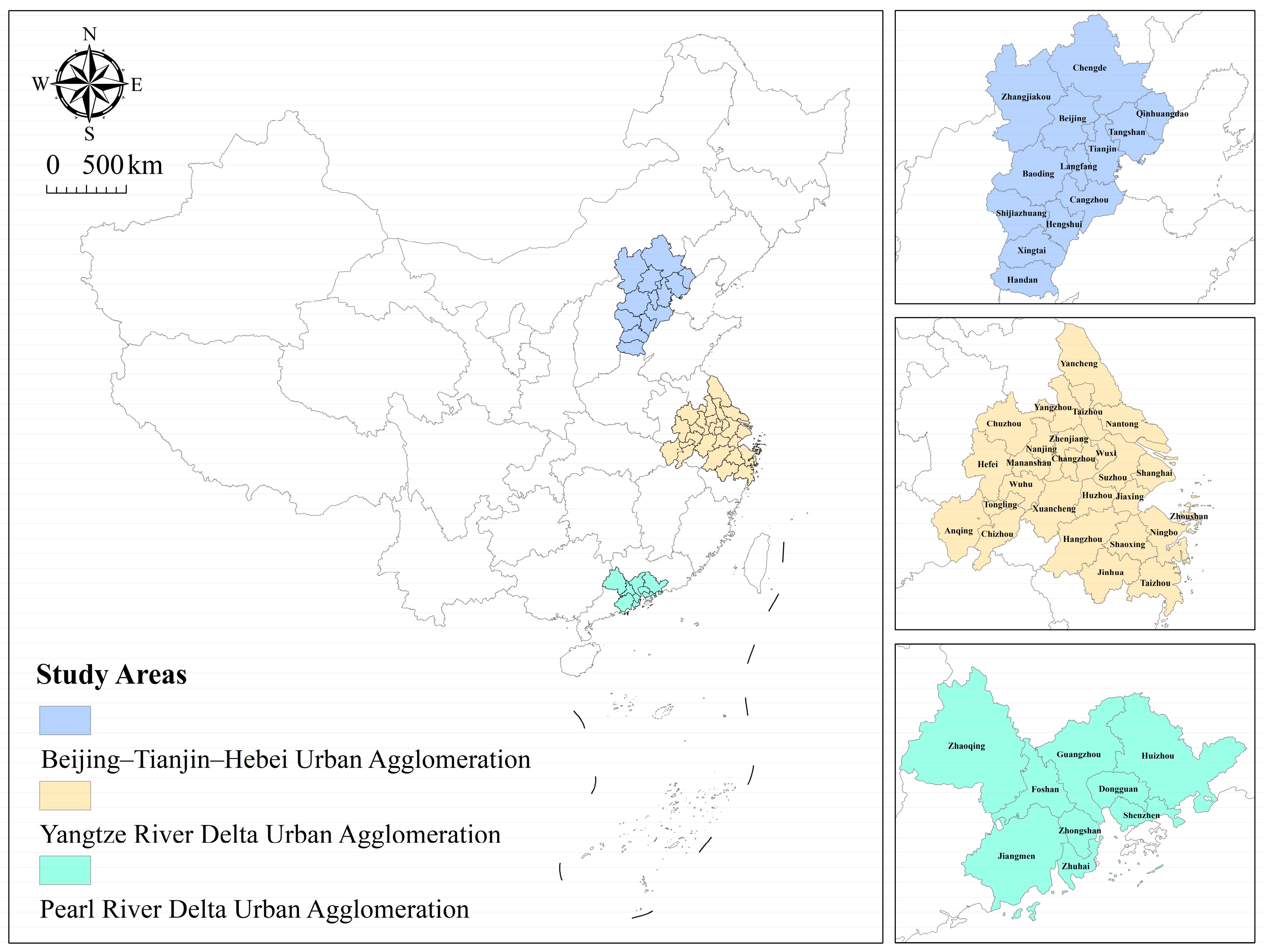

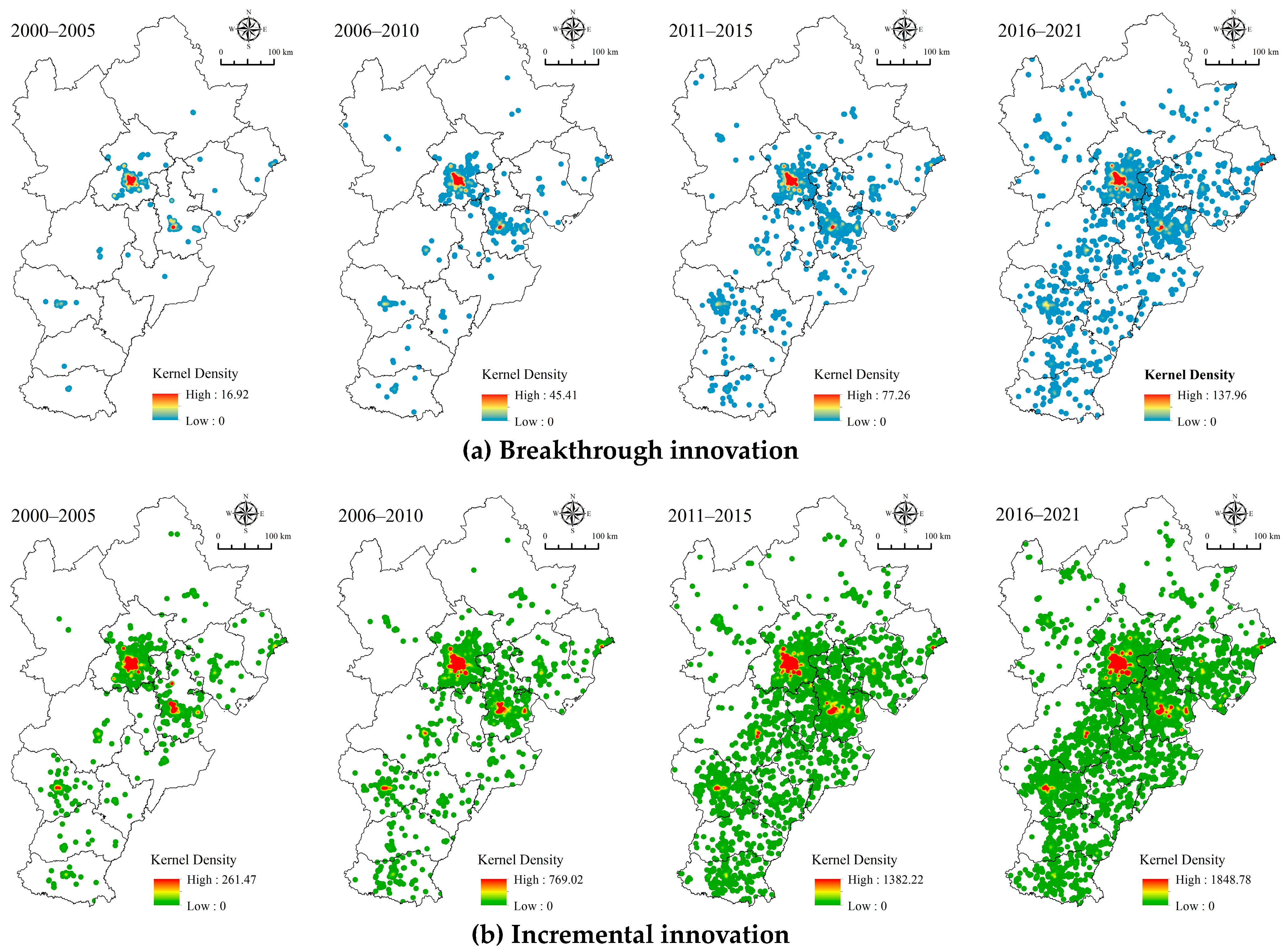
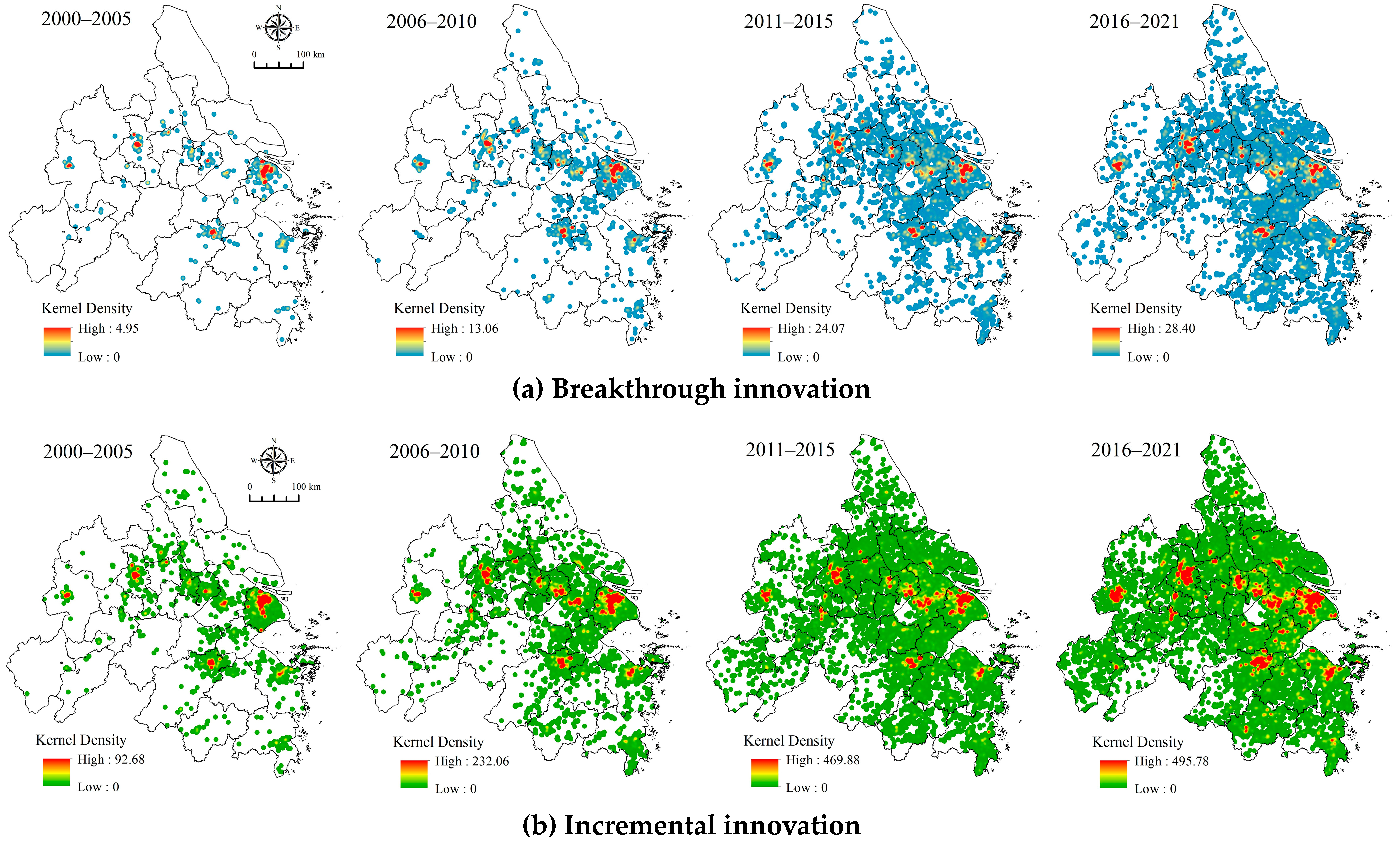
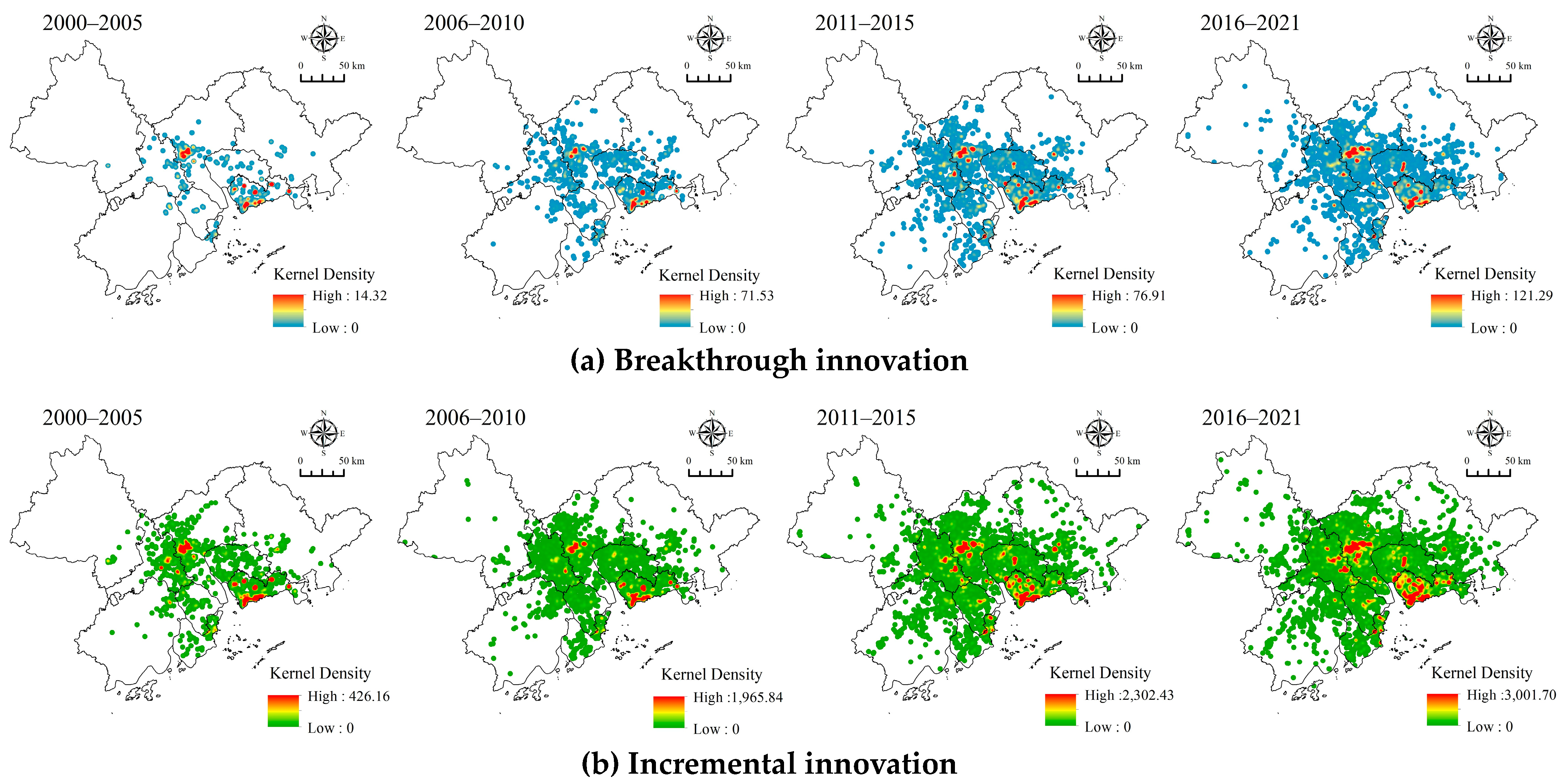

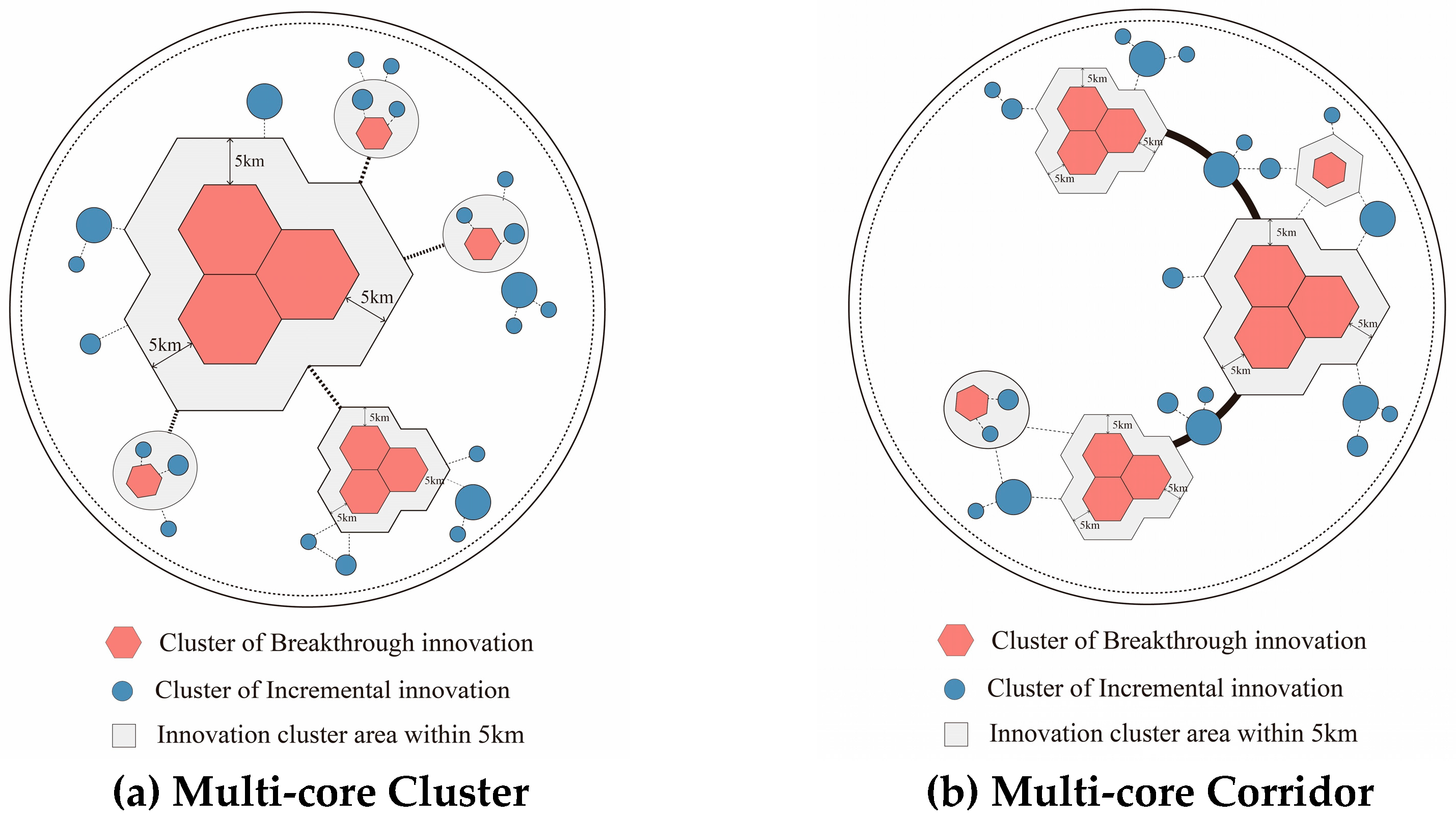
| Dimensions | Impact Factors | Code | Evaluation Index/Unit |
|---|---|---|---|
| Economic foundation | Economic size | GDP | GDP (in billion CNY) |
| Economic development level | PGDP | Per capita GDP (in CNY) | |
| Industrialization level | IndL | Industrialization rate (%) | |
| Resident income | ResI | The average wage of employed staff (in CNY) | |
| Innovation atmosphere | Innovation elements | InnovE | Number of industrial enterprises (units) |
| Government support | GovS | Public financial expenditure on scientific and technological activities (in ten thousand CNY) | |
| Internationalization level | IntL | Actual utilization of foreign capital (in ten thousand USD) | |
| Collaborative innovation | CollabI | Number of cooperative patents (units) | |
| Built environment | Infrastructure | Infra | ) |
| Ecological environment | EcoE | Green coverage rate of built-up areas (%) | |
| Cultural services | CultS | Number of library books per 100 people (pieces) | |
| Public services | PubS | Number of hospital beds (units) |
| Type of Innovation | Impact Factors | 2000–2005 | 2006–2010 | 2011–2015 | 2016–2021 |
|---|---|---|---|---|---|
| Breakthrough innovation | GDP | 0.840 *** | 0.721 *** | 0.639 *** | 0.664 *** |
| PGDP | 0.310 *** | Not Sig. | 0.205 *** | 0.287 *** | |
| IndL | 0.351 *** | 0.881 *** | 0.909 *** | 0.519 *** | |
| ResI | 0.368 *** | 0.918 *** | 0.605 *** | 0.685 *** | |
| InnovE | 0.660 *** | 0.724 *** | 0.627 *** | 0.627 *** | |
| GovS | Not Sig. | Not Sig. | Not Sig. | Not Sig. | |
| IntL | 0.286 *** | 0.523 *** | 0.923 *** | 0.718 *** | |
| CollabI | 0.989 *** | 0.992 *** | 0.979 *** | 0.695 *** | |
| Infra | Not Sig. | Not Sig. | Not Sig. | Not Sig. | |
| EcoE | Not Sig. | 0.880 *** | 0.427 *** | Not Sig. | |
| CultS | 0.892 *** | 0.509 *** | 0.415 *** | Not Sig. | |
| PubS | 0.806 *** | 0.689 *** | Not Sig. | 0.511 *** | |
| Incremental innovation | GDP | 0.628 *** | 0.757 *** | 0.657 *** | 0.705 *** |
| PGDP | 0.341 *** | Not Sig. | 0.180 *** | 0.436 *** | |
| IndL | Not Sig. | 0.761 *** | 0.945 *** | Not Sig. | |
| ResI | 0.422 *** | 0.819 *** | 0.641 *** | 0.819 *** | |
| InnovE | 0.626 *** | 0.810 *** | 0.647 *** | 0.714 *** | |
| GovS | Not Sig. | Not Sig. | Not Sig. | 0.353 *** | |
| IntL | 0.334 *** | 0.502 *** | 0.960 *** | 0.584 *** | |
| CollabI | 0.989 *** | 0.993 *** | 0.992 *** | Not Sig. | |
| Infra | Not Sig. | Not Sig. | Not Sig. | 0.307 *** | |
| EcoE | Not Sig. | 0.772 *** | 0.448 *** | Not Sig. | |
| CultS | 0.994 *** | 0.598 *** | 0.425 *** | 0.463 *** | |
| PubS | 0.559 *** | 0.696 *** | Not Sig. | 0.402 *** |
| Panel Code | ADF | E-G | Hausman Test |
|---|---|---|---|
| P1 | 0.0801 * | 0.0488 ** | 0.0176 ** |
| P2 | 0.0552 * | 0.0777 * | 0.0004 *** |
| P3 | 0.0017 *** | 0.0663 * | 0.0263 ** |
| P4 | 0.0867 * | 0.0424 ** | 0.0002 *** |
| P5 | 0.0038 *** | 0.0305 ** | 0.0024 *** |
| P6 | 0.0141 ** | 0.0956 * | 0.0974 * |
| P7 | 0.0377 ** | 0.0232 ** | 0.0352 ** |
| P8 | 0.0284 ** | 0.0816 * | 0.0646 * |
| Impact Factors | Breakthrough Innovation | Incremental Innovation | ||
|---|---|---|---|---|
| RC | Top 3 Positive Effects | RC | Top 3 Positive Effects | |
| GDP | 1.271 *** | Beijing, Chizhou, Shenzhen | 2.817 ** | Qinhuangdao, Xuzhou, Jiaxing |
| PCGDP | 1.284 ** | Beijing, Shenzhen, Shanghai | 3.094 ** | Beijing, Shanghai, Shenzhen |
| IndL | −4.921 *** | Shenzhen, Foshan, Suzhou | −7.776 ** | Foshan, Shenzhen, Suzhou |
| ResI | −4.921 | Shenzhen, Foshan, Suzhou | 1.287 * | Beijing, Shenzhen, Shanghai |
| GovS | 0.396 *** | Beijing, Shenzhen, Guangzhou | 0.879 *** | Shenzhen, Nanjing, Beijing |
| IntL | 0.513 ** | Beijing, Shenzhen, Shanghai | 1.317 ** | Taizhou, Taizhou, Xingtai |
| CollabI | 0.437 *** | Beijing, Shenzhen, Shanghai | 0.554 *** | Shanghai, Shenzhen, Nanjing |
| EcoE | 1.780 * | Beijing, Shenzhen, Shanghai | 4.721 ** | Shenzhen, Shanghai, Beijing |
| CultS | 1.366 ** | Beijing, Baoding, Hengshui | 3.142 * | Baoding, Xuzhou, Hengshui |
| PubS | 0.273 * | Beijing, Shenzhen, Shanghai | 0.480 ** | Shenzhen, Beijing, Shanghai |
| Impact Factors | Breakthrough Innovation | Incremental Innovation | ||||||
|---|---|---|---|---|---|---|---|---|
| 2000–2005 | 2006–2010 | 2011–2015 | 2016–2021 | 2000–2005 | 2006–2010 | 2011–2015 | 2016–2021 | |
| GDP | 1.675 | 1.845 | 1.730 | 1.660 | 0.750 | 1.294 | 1.472 | 1.453 |
| PCGDP | 2.456 | 3.004 | 2.913 | 3.533 | 0.945 | 1.797 | 2.410 | 1.980 |
| IndL | −0.007 | −2.581 | −3.904 | 0.087 | −1.578 | −3.611 | −3.678 | −2.752 |
| ResI | 4.532 | 7.509 | 0.137 | 6.748 | 1.901 | 5.231 | 6.484 | 5.392 |
| GovS | 1.115 | 1.038 | 1.069 | 1.279 | 0.552 | 0.687 | 0.927 | 0.962 |
| IntL | 0.935 | 0.944 | 0.809 | 0.859 | 0.364 | 0.655 | 0.707 | 0.734 |
| CollabI | 0.991 | 0.994 | 1.005 | 0.204 | 0.466 | 0.630 | 0.877 | 0.711 |
| EcoE | 0.836 | 3.774 | 4.673 | 3.783 | 0.362 | 1.868 | 4.048 | 0.219 |
| CultS | 1.727 | 1.543 | 1.294 | 1.932 | 0.862 | 1.067 | 1.158 | 1.234 |
| PubS | 1.858 | 1.747 | 0.236 | 1.330 | 0.990 | 1.361 | 0.182 | 1.540 |
Disclaimer/Publisher’s Note: The statements, opinions and data contained in all publications are solely those of the individual author(s) and contributor(s) and not of MDPI and/or the editor(s). MDPI and/or the editor(s) disclaim responsibility for any injury to people or property resulting from any ideas, methods, instructions or products referred to in the content. |
© 2024 by the authors. Licensee MDPI, Basel, Switzerland. This article is an open access article distributed under the terms and conditions of the Creative Commons Attribution (CC BY) license (https://creativecommons.org/licenses/by/4.0/).
Share and Cite
Chen, Q.; Liu, Y.; Yao, Z. Spatial–Temporal Pattern Evolution and Differentiation Mechanism of Urban Dual Innovation: A Case Study of China’s Three Major Urban Agglomerations. Land 2024, 13, 1399. https://doi.org/10.3390/land13091399
Chen Q, Liu Y, Yao Z. Spatial–Temporal Pattern Evolution and Differentiation Mechanism of Urban Dual Innovation: A Case Study of China’s Three Major Urban Agglomerations. Land. 2024; 13(9):1399. https://doi.org/10.3390/land13091399
Chicago/Turabian StyleChen, Qingyi, Yuting Liu, and Zuolin Yao. 2024. "Spatial–Temporal Pattern Evolution and Differentiation Mechanism of Urban Dual Innovation: A Case Study of China’s Three Major Urban Agglomerations" Land 13, no. 9: 1399. https://doi.org/10.3390/land13091399






